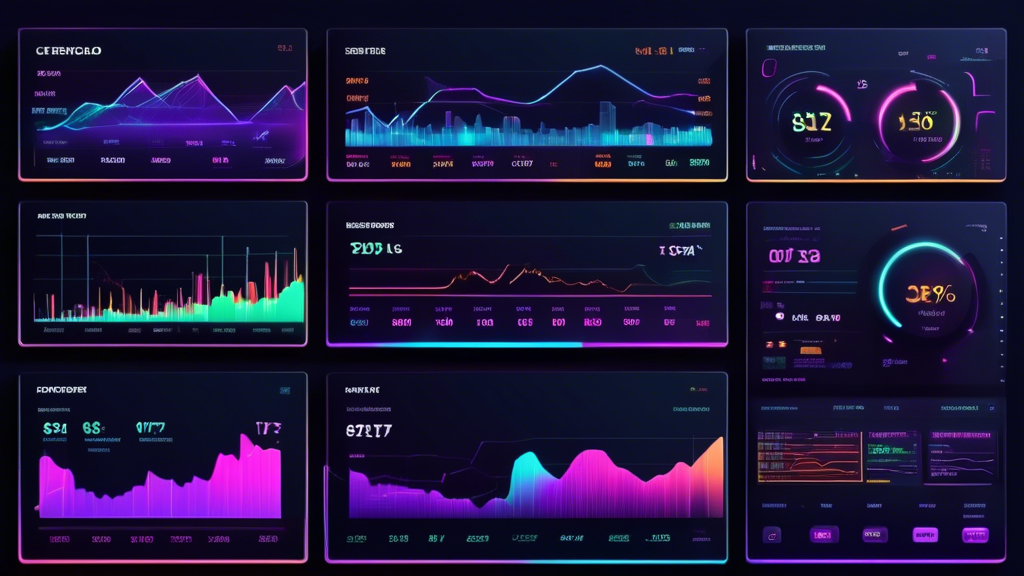In today's rapidly evolving digital economy, crypto trading has emerged as a pivotal component, enabling…
Understanding Crypto Trading with Moving Averages

In recent years, crypto trading has emerged as a significant player in the global financial landscape, captivating investors with its potential for high returns and unique opportunities. As the digital currency market continues to expand, traders are increasingly seeking effective strategies to navigate its volatility. One of the most widely utilized tools in technical analysis is the moving average, which helps traders identify trends and make informed decisions. Moving averages smooth out price data to create a clearer picture of price trends, offering insights into potential entry and exit points.
Understanding the intricacies of moving averages and their application in crypto trading can be the key to enhancing trading performance. By integrating these indicators into trading strategies, traders can gain a strategic advantage over market fluctuations. As we explore the different types of moving averages, their benefits and drawbacks, and the best practices for using them, this article aims to equip you with the knowledge to excel in crypto trading. Whether you’re a novice or an experienced trader, understanding how to implement moving averages effectively can empower you to make more informed decisions in an ever-evolving marketplace. Join us as we delve into the critical role of moving averages in shaping your trading strategies in the dynamic world of cryptocurrency.
Introduction to Crypto Trading and Moving Averages
Crypto trading has emerged as a significant aspect of the financial landscape, attracting both institutional and individual investors. With the decentralized nature of cryptocurrencies, traders engage in buying and selling digital assets with the aim of capitalizing on market fluctuations. The volatility inherent in the crypto markets can lead to both opportunities and risks, emphasizing the need for effective trading strategies. One such strategy that has gained traction among traders is the use of moving averages.
What are Moving Averages?
Moving averages are mathematical calculations that allow traders to analyze the price of a cryptocurrency over a specific time frame. They serve as indicators that smooth out price fluctuations, enabling traders to identify trends and potential reversal points more easily. By averaging past price data, moving averages provide a clearer picture of the market direction, helping traders make informed decisions.
The Role of Moving Averages in Technical Analysis
In the realm of technical analysis, moving averages play a crucial role in the development of trading strategies. They are used to track momentum and identify potential buy or sell signals. The basic premise is that when the price of an asset moves above a moving average, it may indicate a bullish trend, while a price drop below the moving average may signal a bearish trend. This valuation method helps traders gauge market sentiment and make proactive trading decisions.
Importance of Moving Averages in Crypto Trading Strategies
Incorporating moving averages into crypto trading strategies offers several advantages:
- Trend Identification: Moving averages help traders identify the prevailing trend in the market, aiding in the decision to enter or exit trades.
- Signal Generation: They generate signals for potential buy or sell opportunities through crossovers, which occur when a shorter-term moving average crosses a longer-term moving average.
- Risk Management: Using moving averages can enhance risk management by helping traders define their entry and exit points based on historical data.
- Smoothing Volatility: By smoothing out price data, moving averages assist traders in focusing on the larger market trends rather than getting overwhelmed by short-term volatility.
Conclusion
As traders continue to navigate the evolving landscape of digital currencies, understanding the concepts of crypto trading and moving averages becomes essential. They serve as fundamental tools that can provide insights into market dynamics, potentially leading to more informed trading decisions.

Types of Moving Averages Used in Crypto Trading
Moving averages are crucial tools in crypto trading, allowing traders to smooth price data to identify trends over specific periods. Understanding the different types of moving averages, their benefits, and how to apply them in real-world scenarios can enhance trading strategies significantly. Below, we explore the primary types of moving averages used in crypto trading.
1. Simple Moving Average (SMA)
- Definition: The Simple Moving Average is calculated by adding the closing prices of a cryptocurrency over a specific number of periods and dividing that sum by the number of periods.
- Formula: SMA = (P1 + P2 + … + Pn) / n, where P is the price and n is the number of periods.
- Use Case: Perfect for identifying overall trends over time, SMA is generally used for longer time frames, such as the 50-day or 200-day SMA.
Benefits of SMA:
- Very easy to calculate and understand.
- Provides a clear picture of the price trend over a specific timeframe.
- Useful for identifying support and resistance levels.
Drawbacks of SMA:
- Can lag significantly in volatile markets, leading to late signals.
- Less sensitive to recent price movements compared to other moving averages.
2. Exponential Moving Average (EMA)
- Definition: The Exponential Moving Average gives more weight to the most recent prices, making it more responsive to new information.
- Formula: EMA = (Current Price x K) + (Previous EMA x (1 – K)), where K = 2 / (n + 1).
- Use Case: Commonly used in shorter time frames, such as the 12-day or 26-day EMA, to capture quick price changes.
Benefits of EMA:
- More responsive to price changes, making it suitable for dynamic markets like cryptocurrencies.
- Can help traders stay ahead by quickly responding to sudden market movements.
Drawbacks of EMA:
- Can produce false signals when price movements are abrupt.
- More complex to calculate than SMA, which may deter some traders.
3. Weighted Moving Average (WMA)
- Definition: The Weighted Moving Average assigns a weight to each price in the period, with more recent prices receiving more weight.
- Formula: WMA = (P1 x 1 + P2 x 2 + … + Pn x n) / (1 + 2 + … + n).
- Use Case: Effective for medium-term trading strategies where recent data should be emphasized.
Benefits of WMA:
- More accurate reflection of recent price movements compared to SMA.
- Helps smooth out price fluctuations while still being sensitive to changing trends.
Drawbacks of WMA:
- More complicated to calculate than SMA and EMA, requiring additional computation for weights.
- Can still lag behind price movements, albeit less so than SMA.
4. Hull Moving Average (HMA)
- Definition: The Hull Moving Average aims to reduce lag and improve responsiveness by using both weighted averages and square roots.
- Formula: HMA = WMA(2 x WMA(n/2) – WMA(n)), where WMA is the Weighted Moving Average.
- Use Case: Useful for day trading and shorter-term trading strategies due to its rapid responsiveness.
Benefits of HMA:
- Focuses on reducing lag significantly while smoothing price data.
- Helps identify abrupt changes in market direction quickly.
Drawbacks of HMA:
- More complex formula may not be suitable for all traders.
- In extremely volatile markets, it may still present false signals.
Real-World Application Examples
Here’s how these moving averages can be applied in crypto trading strategies:
| Moving Average | Scenario | Expected Outcome |
|---|---|---|
| SMA | Using a 200-day SMA to determine long-term trends. | Identifying bull and bear markets clearly. |
| EMA | Utilizing a 12-day EMA for a quick entry in uptrends. | Making timely trades based on rapid price changes. |
| WMA | Implementing a WMA for medium-term trades. | Balancing sensitivity with less noise in price movement. |
| HMA | Employing HMA for fast-moving trades on short timeframes. | Quick reactions to sudden shifts in market direction. |
Understanding the characteristics of each moving average allows traders to choose the right type based on their trading style, objectives, and the specific market conditions of the cryptocurrencies they invest in. By integrating these tools with other technical analysis methods, traders can enhance their decision-making processes, thereby optimizing their overall trading performance.

Strategies for Integrating Moving Averages in Crypto Trading
Popular Trading Strategies Utilizing Moving Averages
- Crossover Strategies:
- Golden Cross: Occurs when a short-term moving average crosses above a long-term moving average, signaling a potential bullish trend.
- Death Cross: Occurs when a short-term moving average crosses below a long-term moving average, indicating a potential bearish trend.
- Trend Following:
- Utilizing moving averages to identify and follow the prevailing market trend, buying when prices are above the moving average and selling when they dip below.
- Bands and Envelopes:
- Creating upper and lower bands around a moving average to identify overbought or oversold conditions.
- Moving Average Convergence Divergence (MACD):
- A trend-following momentum indicator that shows the relationship between two moving averages of a security’s price.
Step-by-Step Guide to Setting Up Moving Averages on Trading Platforms
- Choose a Trading Platform:
Platforms such as Binance, Coinbase, or TradingView are popular choices for traders.
- Log in to Your Account:
Ensure that you are logged into the trading platform to access the charting tools.
- Select the Cryptocurrency Pair:
Choose the specific crypto asset you want to analyze (e.g., BTC/USD).
- Access the Charting Tools:
Navigate to the chart section of the platform to display price charts.
- Add Moving Average Indicators:
Look for the ‘Indicators’ option (often a magnifying glass or indicator icon) and select ‘Moving Average’. Apply the desired type (SMA, EMA) and set the period (e.g., 50-day, 200-day).
- Customize Settings:
Adjust the color, line thickness, and other settings to distinguish moving averages clearly on your chart.
- Analyze the Chart:
Study how the moving averages interact with price movements to identify potential buy and sell signals based on your chosen strategy.
Tips for Effectively Interpreting Signals Generated by Moving Averages
- Confirm with Additional Indicators:
Use other indicators such as Relative Strength Index (RSI) or MACD alongside moving averages for stronger confirmation of buy/sell signals.
- Use Multiple Time Frames:
Analyze moving averages on different time frames (e.g., daily, weekly) to get a comprehensive view of market trends and potential reversals.
- Watch for Retests:
After a crossover or trend change, watch for price to retest the moving average. This can indicate a stronger signal if the price bounces back off the MA.
- Adjust Period Settings:
Experiment with different time periods for moving averages to tailor your strategy according to the asset’s volatility and your trading style.
- Stay Updated on Market Conditions:
Be aware of external factors affecting crypto prices, including news events and market sentiment, as they can influence the effectiveness of moving average signals.
Educational Resources
For traders looking to deepen their understanding of crypto trading and moving averages, consider the following resources:
- Investopedia: Moving Averages Explained
- TradingView: Learning Center
- CNBC: Technical Analysis for Cryptocurrency Trading

Common Mistakes and Best Practices in Crypto Trading with Moving Averages
Understanding the common mistakes when using moving averages in crypto trading is crucial for traders seeking to enhance their strategy and improve their outcomes. Below, we outline frequent pitfalls alongside best practices to optimize the use of moving averages in trading decision-making.
Common Pitfalls in Using Moving Averages
- Overreliance on Moving Averages: Many traders tend to rely solely on moving averages without considering other indicators or market conditions. This narrow focus can lead to false signals and missed opportunities.
- Ignoring Timeframes: Using the same moving average period across various timeframes can obscure important trends. For example, relying on a 50-day moving average in a 5-minute chart may not provide relevant insights.
- Inadequate Backtesting: Failing to backtest their strategies with historical data can lead traders to adopt ineffective setups. This omission can put their funds at risk.
- Chasing Losses: Traders might increase their stakes after losses, expecting moving averages to correct their positions quickly. This often results in exacerbating losses rather than recovering.
- Forgetting Market Sentiment: Crypto markets can be significantly influenced by news, events, and sentiments. Ignoring broader market factors while using moving averages can lead to misleading conclusions.
Best Practices for Using Moving Averages in Crypto Trading
- Use Multiple Indicators: Incorporate moving averages with other technical indicators (e.g., RSI, MACD) to create a more comprehensive trading strategy. This approach provides better validation of signals.
- Adjust Timeframes Based on Strategy: Tailor your moving average periods to match your trading strategy. Day traders might prefer shorter moving averages (e.g., 5 or 10-period), while long-term investors may opt for longer averages (e.g., 50 or 200-period).
- Conduct Thorough Backtesting: Before implementing a strategy using moving averages, backtest it against historical data to gauge effectiveness and refine the approach. Utilize tools such as TradingView or MetaTrader for this purpose.
- Develop a Risk Management Strategy: Set clear rules regarding stop-loss and take-profit levels based on moving average signals. This disciplined approach helps in mitigating risks associated with volatile crypto markets.
- Stay Informed on Market Dynamics: Keep abreast of market news and events that can influence price movements. Being informed allows traders to better interpret moving average signals in context.
Integrating Moving Averages with Market Sentiment
Another key aspect of successful crypto trading is understanding how market sentiment interacts with moving averages. Here are some strategies to consider:
- Combining Moving Averages with Sentiment Analysis: Utilize sentiment analysis tools to gauge trader emotions. If sentiment aligns with a moving average crossover (e.g., bullish sentiment with a bullish crossover), it can reinforce the reliability of the signal.
- Monitor Social Media and News Trends: Platforms like Twitter and Reddit can provide real-time insights into prevailing market sentiment. Awareness of changes in sentiment can help validate or refute moving average signals.
- Reacting to Major News Events: Be prepared for increased volatility following significant announcements or developments within the crypto sector (e.g., regulatory news). Recognize that moving averages may not always predict price movements accurately in these situations.
The Importance of Flexibility
Flexibility in trading is vital when applying moving averages in crypto trading. Here are some practices to enhance adaptability:
- Continuous Learning: Stay updated on new methodologies and theories in technical analysis that might improve the use of moving averages. Consider webinars, forums, and courses focused on trading strategies.
- Adapting to Market Conditions: Markets can shift from trending to ranging; be prepared to adjust your moving average strategy accordingly. This might include experimenting with different types of moving averages (e.g., EMA vs. SMA) based on market behavior.
- Regularly Review Your Strategy: Revisit your trading plan periodically to assess its effectiveness. Update moving average settings based on evolving market conditions or personal trading goals.
By avoiding common pitfalls and implementing best practices for optimizing moving average usage, traders can make informed decisions that increase their chances of success in the ever-evolving landscape of crypto trading. For further resources on technical analysis and moving averages, consider visiting Investopedia or TradingView for insightful articles and tools.
In conclusion, understanding the integration of moving averages in crypto trading is essential for both novice and experienced traders aiming to navigate the volatile landscape of cryptocurrencies. Moving averages serve as a foundational tool in technical analysis, providing critical insights into price trends and potential future movements. By familiarizing oneself with the different types of moving averages, such as Simple Moving Averages (SMAs) and Exponential Moving Averages (EMAs), traders can tailor their strategies to align with their trading styles and risk tolerance.
The application of moving averages in trading strategies, particularly through crossover techniques and trend-following methods, illustrates their practicality in making informed decisions. Additionally, mastering the setup of moving averages on various trading platforms and understanding how to interpret the signals they generate can significantly enhance a trader’s ability to predict market shifts.
However, it is crucial to acknowledge the common mistakes that can arise from overreliance on these indicators, such as failing to consider market conditions or using inappropriate time frames. By adhering to best practices and staying informed about market dynamics, traders can better leverage moving averages to improve their trading outcomes.
As the world of crypto trading continues to evolve, so too will the strategies utilized by traders. Moving averages will likely remain a staple in the toolkit of crypto traders, evolving alongside new technologies and market trends. Embracing a disciplined approach to trading that incorporates moving averages, while remaining adaptable to changes in the market, is key to sustaining success in this rapidly changing financial landscape. For those looking to deepen their knowledge, consider exploring additional resources on technical analysis and trading strategies for a more comprehensive understanding of how to effectively utilize moving averages in your trading practices.





